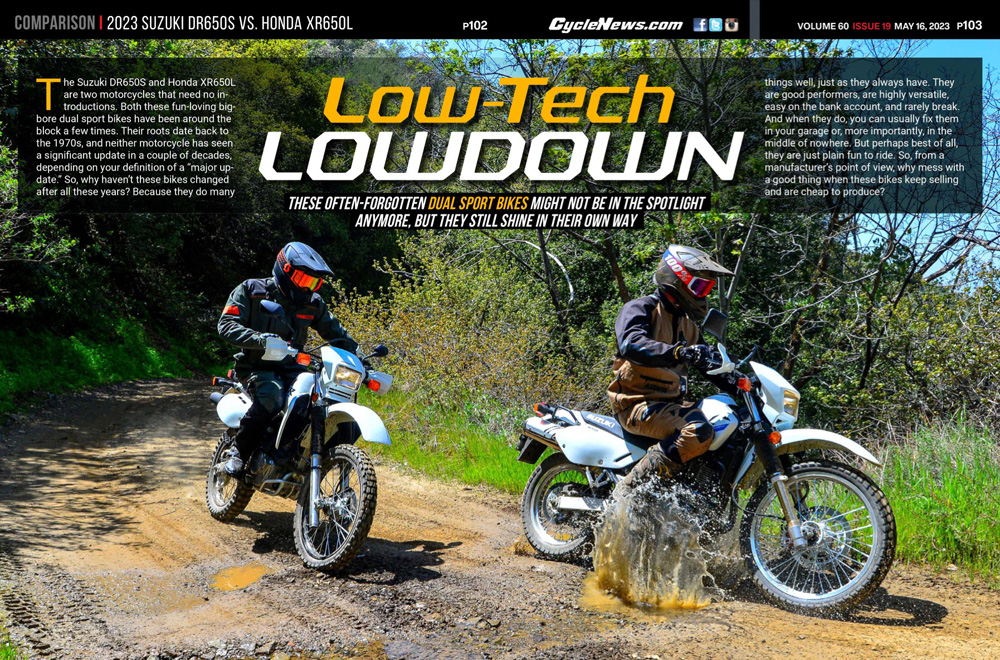Cycle News Staff | May 22, 2023
These often-forgotten dual-sport bikes might not be in the spotlight anymore, but they still shine in their own way.
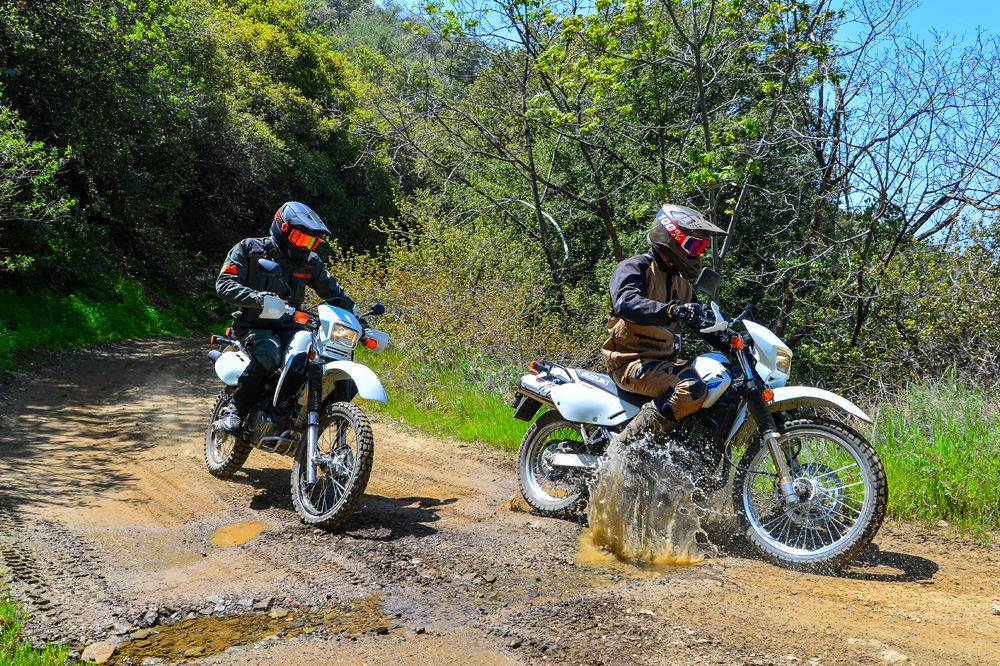
By the CN Staff | Photography by Kit Palmer
The Suzuki DR650S and Honda XR650L are two motorcycles that need no introductions. Both these fun-loving big-bore dual sport bikes have been around the block a few times. Their roots date back to the 1970s, and neither motorcycle has seen a significant update in a couple of decades, depending on your definition of a “major update.” So, why haven’t these bikes changed after all these years? Because they do many things well, just as they always have. They are good performers, are highly versatile, easy on the bank account, and rarely break. And when they do, you can usually fix them in your garage or, more importantly, in the middle of nowhere. But perhaps best of all, they are just plain fun to ride. So, from a manufacturer’s point of view, why mess with a good thing when these bikes keep selling and are cheap to produce?
Both these bikes were considered high-end dual sport bikes in their early days, but technology and the years have passed them by, so their roles have changed. Today, the Suzuki DR650S and Honda XR650L, which both companies still market as dual sport bikes, are often looked at more as affordable, naked, but very customizable, adventure bikes, capable of being ridden long, medium or short distances in relative comfort on both pavement and dirt, including semi-challenging dirt trails and single-track. And they also make good short-distance commuters and around-town go-getters. Heck, you can do almost anything happily on these bikes.
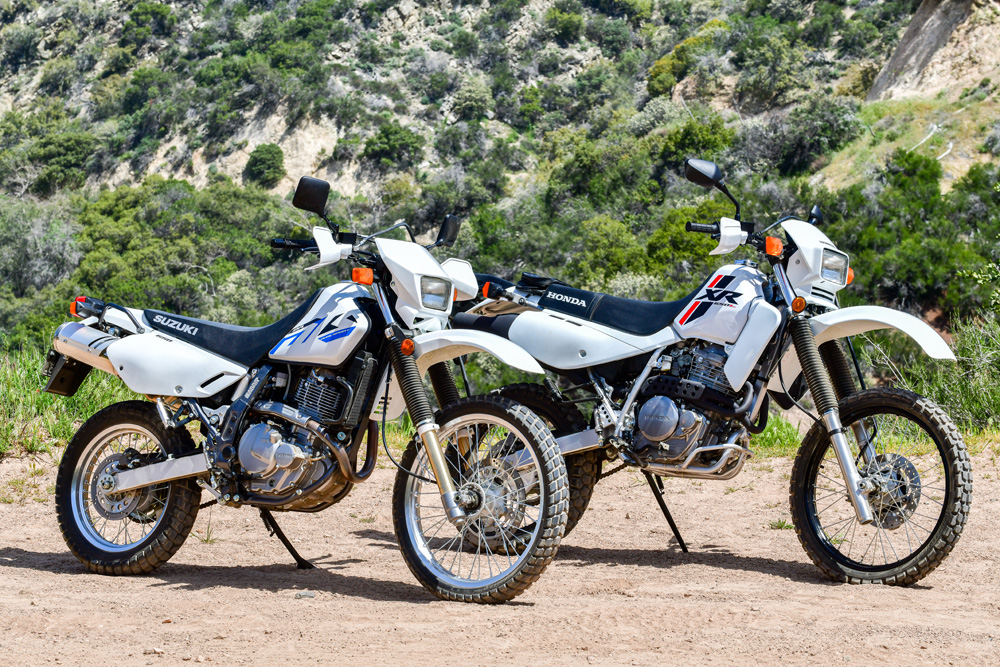 The Suzuki DR650S and Honda XR650L are versatile old-school dual sport bikes that are still attractive because of their simplicity, torquey engines, and affordable price tags.
The Suzuki DR650S and Honda XR650L are versatile old-school dual sport bikes that are still attractive because of their simplicity, torquey engines, and affordable price tags.
Apples To Apples?
So, what is the difference between the DR and XR? According to their specs, only a little. They are powered by single-cylinder, four-stroke, four-valve SOHC engines with the same 644cc displacement and 100 x 82mm bore and stroke.
Both bikes are carbureted and distribute power to their rear wheels via a five-speed gearbox and a multiplate cable-operated clutch.
There are some notable differences, however. The DR uses a traditional wet-sump design to lubricate its engine, while the XR carries oil in its frame (dry sump), resulting in a more compact engine and significantly more ground clearance (due to its smaller engine), 13 inches versus the Suzuki’s 10.4 inches. The Honda’s compression ratio is considerably less than the Suzuki’s, 8.3:1 versus 9.5:1. (Nice to know when you are forced to run low-grade fuel.)
The Suzuki relies on a combination of air and oil cooling, the Honda strictly air.
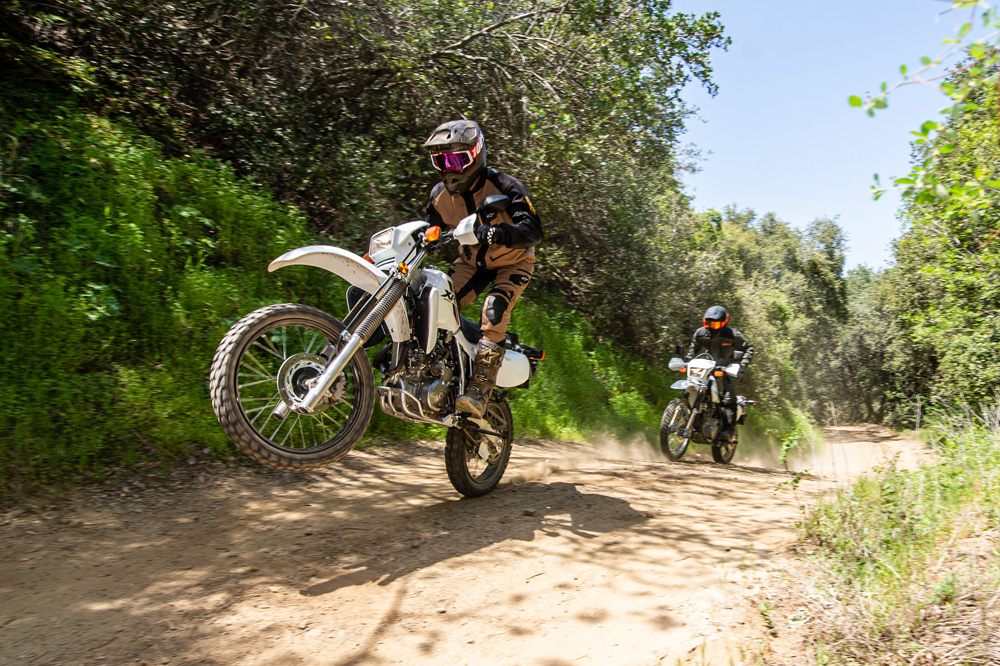 If you’re not in a big hurry to get to where you’re going, both bikes are big (literally) fun.
If you’re not in a big hurry to get to where you’re going, both bikes are big (literally) fun.
In the chassis department, their foundations are also similar. They both have steel frames, link-type single-shock rear suspension systems, conventional telescopic forks and disc brakes sans ABS.
Here’s where things start separating: The Honda’s suspension is more adjustable and higher-end than the Suzuki’s, and the Honda weighs approximately 20 pounds less than the Suzuki at a claimed 346 (curb) pounds, opposed to the Suzuki’s 366 (curb) pounds. The Honda also comes with an 18-inch rear wheel, the Suzuki 17-inch. The Suzuki holds more fuel at 3.4 gallons, the Honda 2.8 gallons. And here’s a possible sticking point for some when it comes to the XR—the Honda’s seat height is significantly higher than the Suzuki’s at 37.0 inches, versus 34.8 inches for the DR. And adding insult to injury, the Suzuki’s suspension can be lowered, which reduces seat height a further 1.8 inches! (Though you do lose some wheel travel.) Honda offers no such option, which it should, considering the XR’s towering height.
So, as you can see, these bikes are very similar on paper but have their differences.
As far as price, there is no debate. Both bikes sell for $6999.
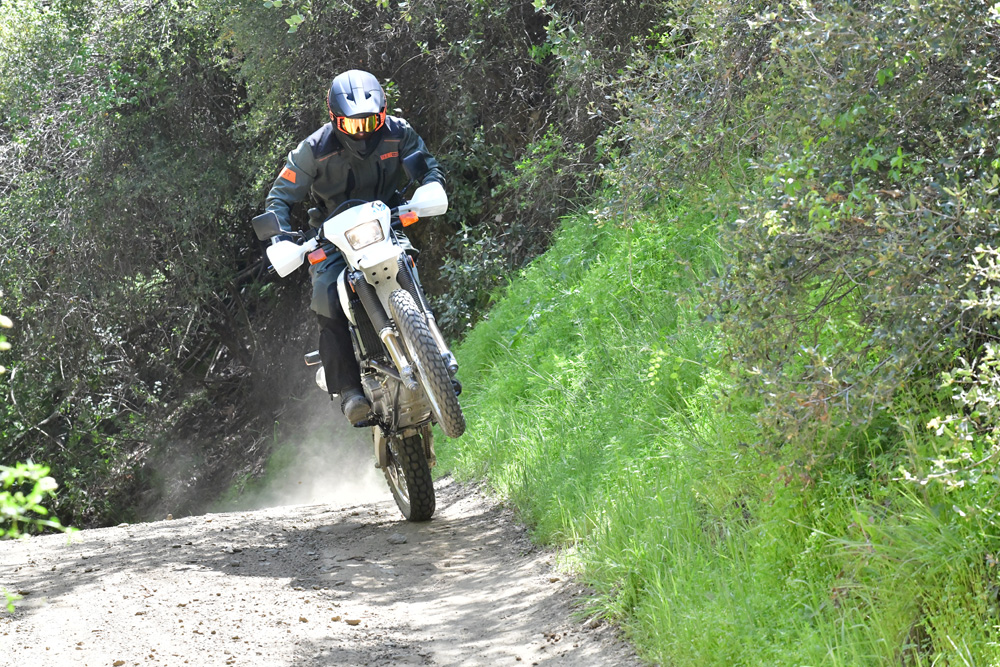 The DR is no featherweight.
The DR is no featherweight.
Oranges To Oranges?
You’ll immediately notice the Honda’s height when you throw a leg over it. It’s tall! And you don’t need to sit on the much lower Suzuki for verification. But, yes, in comparison, the XR feels way taller than the DR, and for some perspective buyers, this alone could be a dealbreaker in the DR’s favor.
Both bikes have large and wide La-Z-Boys for seats. Very old-school. But, old-school or not, they are admittedly comfy. They are so comfy, in fact, that you never want to get out of them. Their funky handlebar positionings certainly don’t encourage you to stand up, either—they are both positioned so low they feel like they are in your lap. Most DR owners raise the handlebar mounts, and all XR owners trash the stock handlebars for something taller with a normal bend. (Where did they come up with these in the first place?) Overall, both bikes are acceptably comfortable—more so the Suzuki—but only in the sitting position. Neither bike is conducive to standing, and their small 1980s-style footpegs only worsen matters.
Starting procedure for both bikes is the same: reach for their handlebar choke levers, hit the starter button, and be patient while they take their sweet time warming up. There are zero rider aids to deal with (not even ABS), no menus to scroll through, and no modes to choose from. Just go ride.
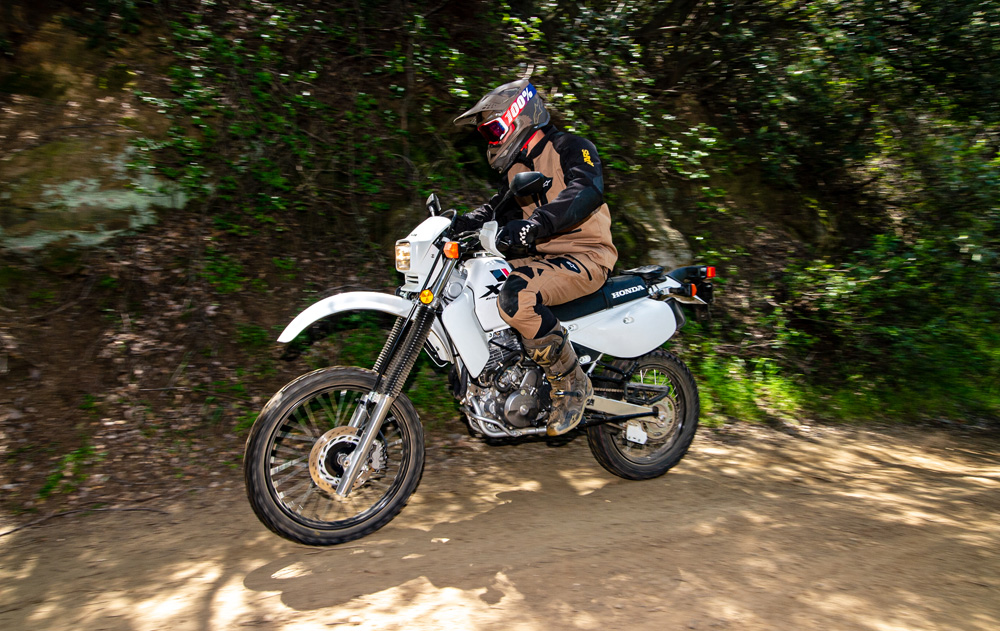 The XR’s engine is all about torque, and you feel every pulse.
The XR’s engine is all about torque, and you feel every pulse.
Once underway, as you grab a handful of throttle and click through the gears for the first time, you’ll quickly notice the DR is smoother than the XR in just about every way. The DR’s footpegs are rubber-mounted, and handlebar tips have small weights to quell vibration. They work. Mind you, the Honda doesn’t vibrate badly, just more so than the Suzuki.
The Honda and Suzuki deliver similar retro-type power—lots of torque and no revs. Again, the Suzuki delivers its power in a smoother, more seamless manner than the Honda. You feel every power pulse with the Honda, but not so much with the Suzuki. However, some people prefer the feel of a pulsating engine over a rippleless, velvety smooth one. The choice is yours.
Regarding fueling, both bikes are rough around the edges compared to modern big-bore singles with EFI, but overall, both bikes run well but are a little on the lean side.
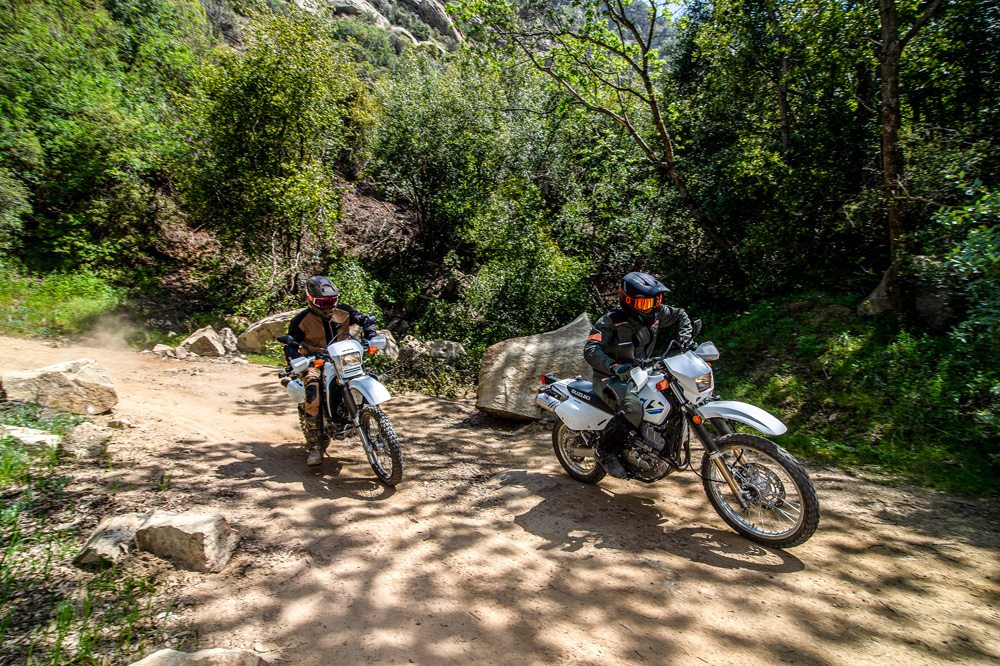
Both bikes could benefit from lower gearing for off-road riding; they are geared quite tall from the factory. This is great if you want to go really, really fast all the time, but it could be better for trail riding. Luckily, both bikes have ample torque and power to get you by. If most of your off-road riding is going to be on slick two-track dirt roads, however, the stock gearing is fine with both bikes; you can take advantage of that beautiful torque they both possess.
The Honda’s suspension far outshines the Suzuki’s in performance and adjustability. The Honda comes fitted with a 44mm Showa cartridge fork, the same fork used by elite off-road racers in the day, such as Scott Summers, who won several GNCC titles on the Honda XR600R. Many still speak highly of this fork, and we do too. The shock is equally good and fully adjustable; the XR’s fork has compression adjustability but no rebound. Those Schrader valves at the top of the Honda’s forks are bleeder valves and have nothing to do with preload, but they help keep the fork performing consistently by eliminating air build-up. The Suzuki’s fork has no bleeder valve.
The Suzuki’s suspension is lower grade in comparison. It isn’t as adjustable as the Honda’s and has approximately an inch less wheel travel and both ends, a reverse side effect of having a lower seat height. Overall, for casual riding, the Suzuki still rides well on the road and even on the dirt, but you’ll reach the limitations of the Suzuki’s suspension far quicker than the Honda’s.
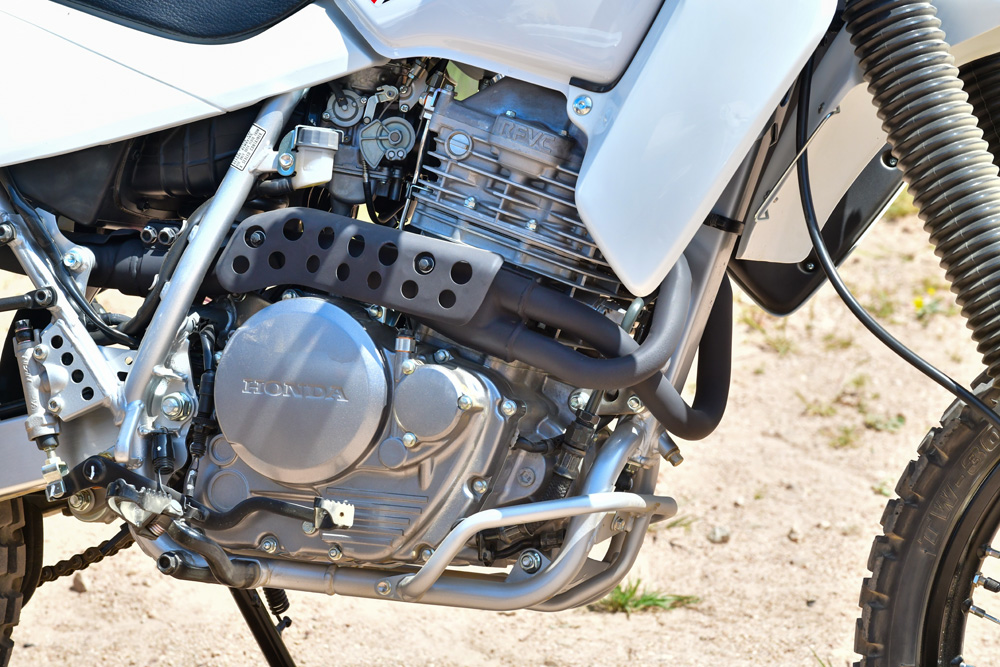 The XR’s engine is all about torque, and you feel every pulse.
The XR’s engine is all about torque, and you feel every pulse.
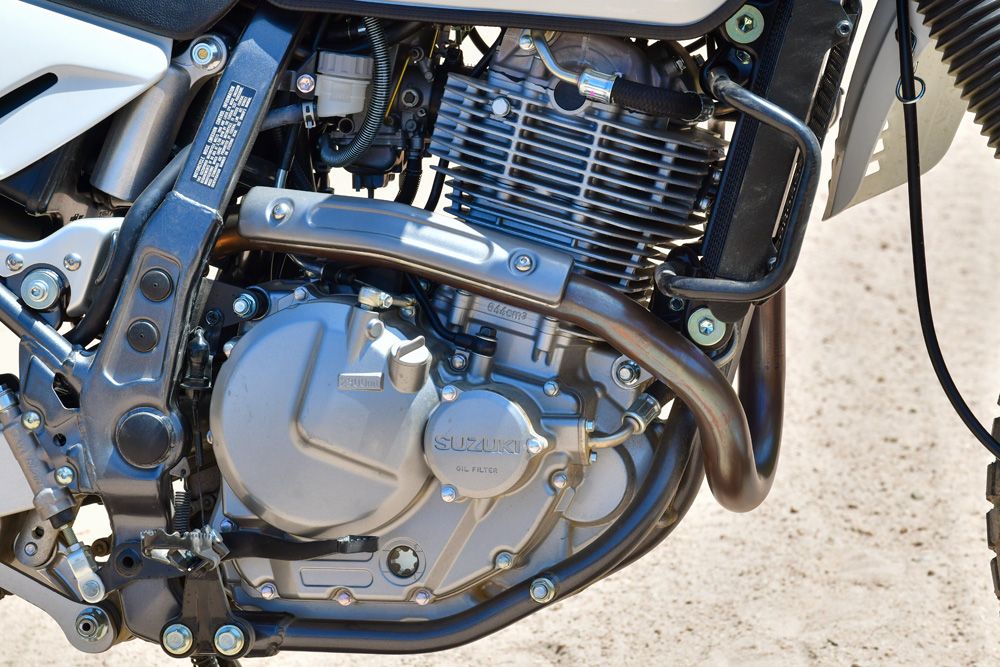 The DR’s dry-sump engine takes up a lot of space and eats up ground clearance.
The DR’s dry-sump engine takes up a lot of space and eats up ground clearance.
Both bikes handle well, but they are heavy. The Suzuki is substantially heavier than the Honda, but the DR’s lower seat height helps make its weight as easy, if not easier, to manage than the ultra-tall XR. Choose your evil here.
In motion, however, both bikes are stable and predictable, and weight isn’t much of a factor, but when things start to get even the slightest bit technical off road, your muscles will start to complain aboard both bikes, and you’ll also wish for better grip from their street-biased tires. The DR is less scary on non-maintained dirt roads because of its lower seat height. But on gnarly rough ground, we’d just as soon be on the Honda for its better suspension.
Both bikes could benefit from more fuel capacity. The Suzuki’s 3.4-gallon capacity, however, is acceptable, the Honda’s 2.8-gallon tank is not, but we’ve been complaining about this for years.
The Suzuki and Honda’s instrumentation are basic and vintage looking. Neither has a low-fuel warning light. They let their petcocks handle that. Both bikes come with handguards and large mirrors, but the XR’s are at least now modern looking compared to the Suzuki’s archaic square mirrors.
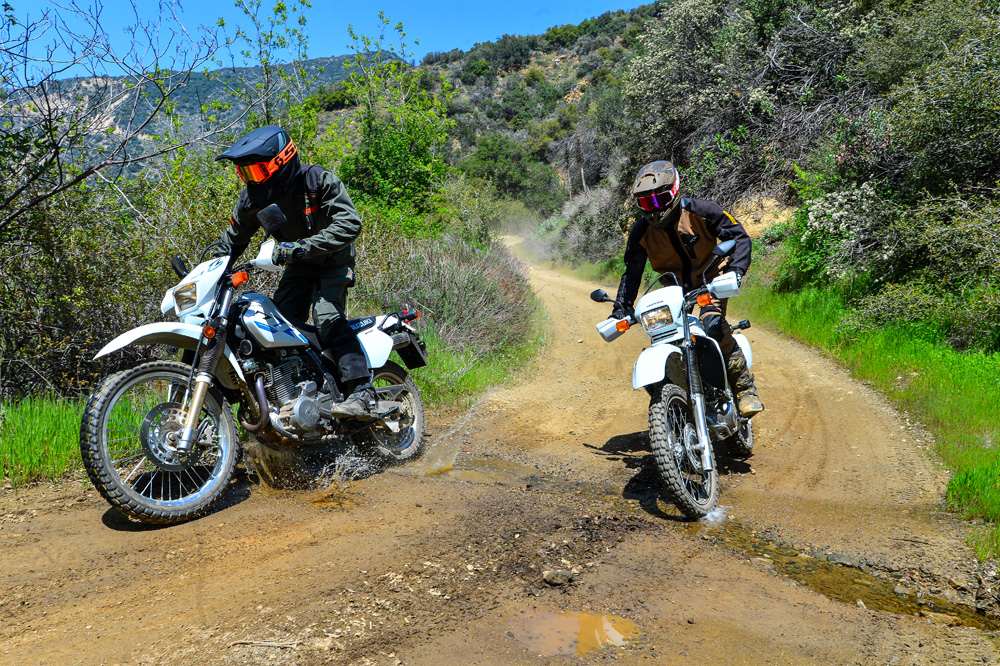 The DR (left) has a much lower seat height but less wheel travel than the long-legged XR.
The DR (left) has a much lower seat height but less wheel travel than the long-legged XR.
Back in the garage after a long day in the saddle, it was unanimous among our testers—the Suzuki wins out. The DR got high marks for its low seat height, ultra-smooth power, superior ergos (but not by much), and more all-around modern feel. The Honda rules in the suspension department, and that alone keeps this bike in the discussion, and so does—well, just being an XR. How can you not consider that? There will always be something special about those two letters, whether it’s the best or not. CN
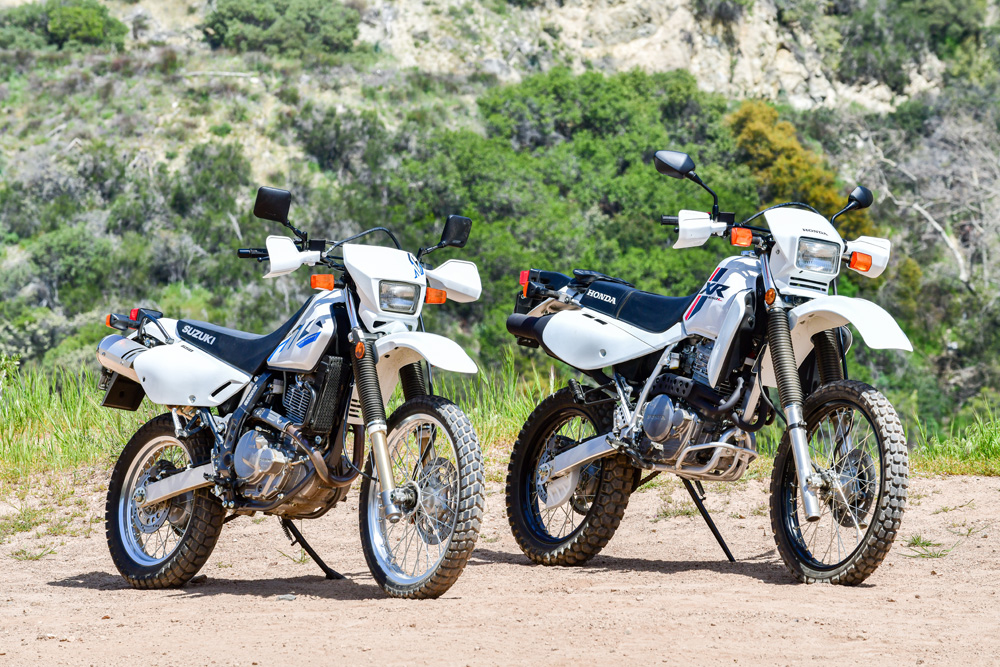
2023 Suzuki DR650S / Honda XR650L Specifications
| MSRP: |
$6999 / $6999 |
| Engine: |
4-stroke, single / 4-stroke, single |
| Displacement: |
644cc / 644cc |
| Cooling System: |
Air-oil / Air |
| Valvetrain: |
4-valve, SOHC / 4-valve RFVC, SOHC |
| Bore x Stroke: |
100.0 x 82.0mm / 100.0 / 82.0mm |
| Compression Ratio: |
9.5:1 / 8.3:1 |
| Electrical System: |
CDI / CDI |
| Starting System: |
Electric / Electric |
| Fuel System: |
Carburetor, Mikuni CV 40mm / Carburetor, Keihin CV 42.5mm |
| Lubrication System: |
Wet sump / Dry sump |
| Transmission: |
5-speed / 5-speed |
| Frame: |
Steel, semi-double cradle / Steel |
| Front Suspension: |
Telescopic fork, non-adjustable / Showa, telescopic fork, cartridge & compression damping adjustability |
| Front-Wheel Travel: |
10.2 in. / 11.6 in. |
| Rear Suspension: |
Single shock, link-type, spring preload w/compression damping adjustability / Single shock, link-type, spring preload w/compression & rebound damping adjustability |
| Rear-Wheel Travel: |
10.2 in / 11.6 in. |
| Front Brake: |
Single, 290mm, floating disc w/2-piston caliper, non-ABS / Single, 256mm disc w/2-piston caliper |
| Rear Brake: |
Single, 240mm disc w/2-piston caliper, non-ABS / Single, 220mm disc w/1-piston caliper |
| Front Wheel: |
90/90-21 in. / 3.00-21 in. |
| Rear Wheel: |
120/90-17 in. / 4.60-18 in. |
| Wheelbase: |
58.7 in. / 57.3 in. |
| Ground Clearance: |
10.4 in. / 13.0 in. |
| Seat Height: |
34.8 in. (33.0 in. lowering kit option) / 37.0 in. |
| Fuel Capacity: |
3.4 gal. / 2.8 gal. |
| Weight (curb, claimed): |
366 lbs. / 346 lbs. |
| Warranty: |
12-month limited / 12-month limited |
VIDEO | Dual Sport Duel: DR650S vs XR650L
DR650S vs XR650L
